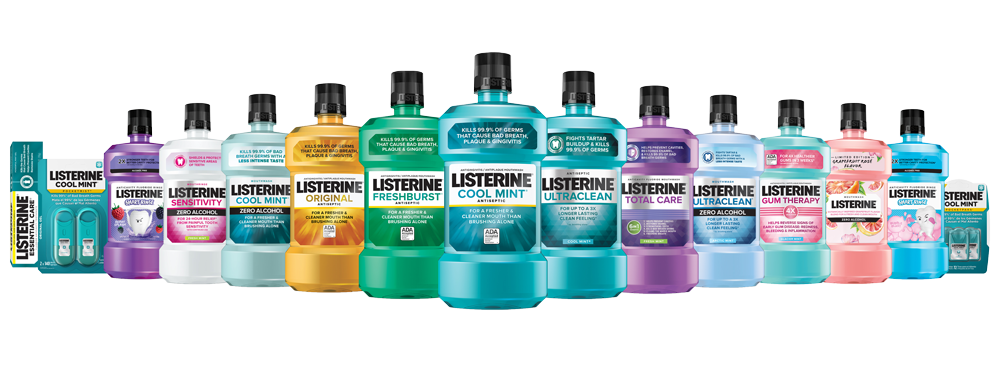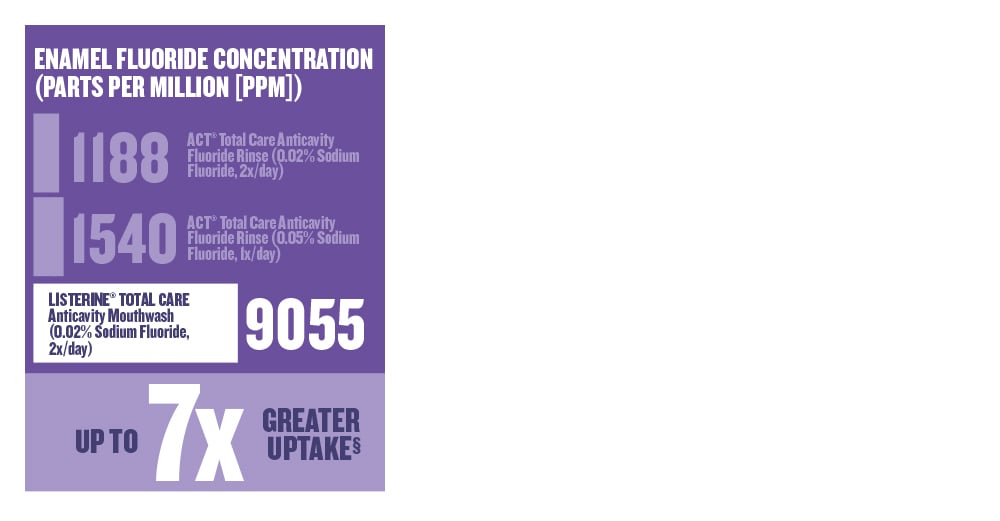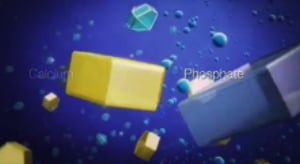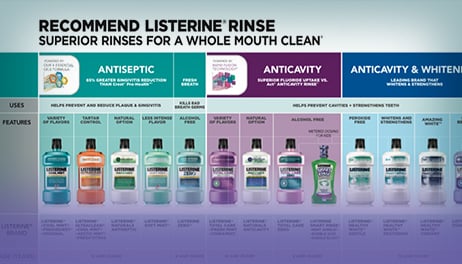

Licensed professionals can receive the latest Listerine clinical information and patient resources.
The alarming prevalence of caries.
The prevalence of dental caries continues to be a challenge for oral healthcare professionals to this day. In fact, an alarming 92% of US adults (aged 20 to 64 years) have a history of caries,1 as well as 42% of children (aged 2 to 11 years).2 While strides have been made since the early 1970s, the problem persists.1,2 In fact, from the mid 1990s until 2004 (according to the National Health and Nutrition Examination Survey), there was a small but significant increase in primary decay.2

This trend was even more severe in younger children,2 with caries in the primary teeth of preschool children increasing from 24% to 28% between 1988 and 2004.3 These early childhood caries (ECC) are a particularly rapid and aggressive form of tooth decay affecting the young. For many children, caries are not being treated and can eventually turn into more serious issues.
ECC is now the most common chronic early childhood disease in the United States—five times more common than asthma.4
Fluoride to the rescue.
Fluoride has long been known as one of the key components to good oral health and the prevention of caries in both children and adults. It is a naturally occurring mineral that makes tooth enamel more resistant to acid-producing bacteria that cause dental caries—while also repairing teeth in the very early, microscopic stages.5,6
While the use of fluoride in toothpaste has been responsible for a drop in caries since 1960,5 this significant problem still persists. Yet, many people do not realize that also using a mouthrinse can result in 50% stronger teeth than brushing with fluoride toothpaste alone.7* In fact, the American Dental Association (ADA) recommends the use of mouthrinses with fluoride to help resist tooth decay.5†
However, while it may appear so on the surface, not all fluoride mouthrinses are created the same.
At the LISTERINE® Brand, our commitment to innovation led to the creation of unique anticavity mouthrinses powered by breakthrough science called RAPID FUSION TECHNOLOGY®—a unique fluoride delivery system which binds calcium ions with fluoride to create fluoride reservoirs that attach to tooth enamel, and are then released over time for a greater fluoride uptake7 and greater enamel content of fluoride to the tooth surface.
Here’s a closer look at how RAPID FUSION TECHNOLOGY® works8-10:
|
RAPID FUSION TECHNOLOGY® provides fluoride in a safe, acidic environment that rapidly liberates calcium and phosphate ions. |
These ions combine to create millions of tiny fluoride reservoirs on tooth enamel and in saliva… |
|
|
|
|
…increasing the amount of fluoride on the tooth surface. |
Throughout the day, as enamel is exposed to acids from dietary sugars, the reservoirs dissolve, and release fluoride to remineralize the teeth. |
 |
 |
|
The fluoride then binds to areas of weak, demineralized enamel and attracts calcium and phosphate from saliva. |
These ions penetrate the enamel and combine with fluoride to create a new, stronger, and more acid-resistant mineral surface. |
 |
|
In this way, RAPID FUSION TECHNOLOGY® enhances remineralization and inhibits demineralization of tooth enamel—to provide:
- 50% stronger teeth than brushing with fluoride toothpaste alone7*
- 68% greater remineralization of enamel compared to ACT® Total Care Fluoride Rinse7‡§
In fact, when compared to ACT® fluoride rinses, LISTERINE® TOTAL CARE has up to a 7x greater fluoride uptake.3§

To learn more about the mechanism of action behind RAPID FUSION TECHNOLOGY®, take a look at our video:
LISTERINE® fluoride mouthrinses for every patient.
We’ve formulated a variety of anticavity mouthrinses to meet the specific needs of any type of patient, all powered by RAPID FUSION TECHNOLOGY®:
For patients 12 years and older who require greater fluoride uptake:
LISTERINE® TOTAL CARE ANTICAVITY MOUTHWASH
- Dosing: Twice daily (after brushing with toothpaste) with 10 mL for 1 minute
LISTERINE® HEALTHY WHITE® VIBRANT ANTICAVITY MOUTHRINSE
- Provides a whiter smile in 5 days, while enamel-safe
- Dosing: Twice daily (after brushing with toothpaste) with 10 mL for 1 minute
For patients 6 years and older who require cavity protection:
LISTERINE® TOTAL CARE ZERO ANTICAVITY MOUTHWASH
- An alcohol-free option with a less intense flavor
- Up to 2.4x greater fluoride uptake vs ACT®7
- Dosing: Twice daily (after brushing with toothpaste) with 10 mL for 1 minute
LISTERINE® SMART RINSE® ANTICAVITY FLUORIDE RINSE
- Alcohol-free formula especially for kids that strengthens teeth 99% better than brushing alone11
- 2.4x greater fluoride uptake vs ACT® Anticavity Kids Fluoride Mouthwash7
- Metered dosing for safety
- Dosing: Twice daily (after brushing with toothpaste) with 10 mL for 1 minute
Fluoride, caries, and you.
As an oral healthcare professional, you’ll hold a unique role in the education of caries prevention for all of your patients—from adults to the youngest and most vulnerable among us. By recommending the addition of a LISTERINE® Anticavity Mouthrinse twice a day to their daily regimen, you can feel confident that you’ve helped improve the outlook of their oral health.
What we’ve learned:
1. What is the prevalence of caries among adults (ages 20-64) in the US?
a.) 24% of adults
b.) 42% of adults
c.) 67% of adults
d.) 92% of adults
2. What is the incremental benefit of fluoride mouthwash in addition to other fluoride treatments?
a.) 20% stronger teeth
b.) 30% stronger teeth
c.) 40% stronger teeth
d.) 50% stronger teeth
3. What is the enamel fluoride concentration after using LISTERINE® mouthrinse compared to ACT®?
a.) 1188 PPM
b.) 1540 PPM
c.) 4548 PPM
d.) 9055 PPM
4. What are the dosing instructions for LISTERINE® Fluoride Mouthwashes?
a.) Twice daily with 10 mL for 30 seconds
b.) Twice daily with 10 mL for 1 minute
c.) Twice daily with 20 mL for 30 seconds
d.) Twice daily with 20 mL for 1 minute
Answers: 1. d; 2. d; 3. d; 4. b.
RAPID FUSION TECHNOLOGY® video.
See the breakthrough science behind every LISTERINE® anticavity product, in action.
EXPLORE OUR PRODUCTS.
See which LISTERINE® products you should consider recommending to your patients.
Fluoride Rinses and Caries Prevention: Footnotes
*Compared to Crest® Fluoride toothpaste and rinsing with water in a laboratory study.
†For patients at a moderate or high risk of developing caries.
‡In a laboratory study.
§Compared to ACT® Total Care Anticavity Fluoride Rinse, ACT® Total Care Anticavity Fluoride Rinse-Alcohol Free, ACT® Total Care Anticavity Fluoride Mouthwash ACT® Restoring™ Anticavity Mouthwash, and ACT® Anticavity Kids Fluoride Rinse in a laboratory study.
References: 1. NIH: National Institute of Dental and Craniofacial Research. Dental caries (tooth decay) in adults (age 20 to 64). NIH Web site. https://www.nidcr.nih.gov/DataStatistics/FindDataByTopic/DentalCaries/De.... Accessed May 11, 2016. 2. NIH: National Institute of Dental and Craniofacial Research. Dental caries (tooth decay) in children (age 2 to 11). NIH Web site. https://www.nidcr.nih.gov/DataStatistics/FindDataByTopic/DentalCaries/De.... Accessed May 11, 2016. 3. Dye BA, Thornton-Evans G, Li X, et al. Dental Caries and Sealant Prevalence in Children and Adolescents in the United States, 2011-2012. Centers for Disease Control and Prevention; NCHS Data Brief. March 2015;19:1-8. 4. American Academy of Pediatric Dentistry. The state of little teeth. http://www.aapd.org/assets/1/7/State_of_Little_Teeth_Final.pdf. Accessed May 11, 2016. 5. Fluoride treatments in the dental office. JADA. 2007;138. http://www.ada.org/~/media/ADA/Member%20Center/FIles/patient_72.ashx. Accessed May 11, 2016.
6. Fluoride. MouthHealthy/American Dental Association. http://www.mouthhealthy.org/en/az-topics/f/fluoride. Accessed May 11, 2016. 7. Data on file, Johnson & Johnson Consumer Inc. 8. González-Cabezas C, Jiang H, Fontana M. Remineralizing effect of low-pH fluoride treatment on advanced non-cavitated lesions. Caries Res. Abstract 115. 2009;43:220. 9. Friberger P. The effect of pH upon fluoride uptake in intact enamel. Scand J Dent Res. 1975;83(6):339-344. 10. Delbem AC, Tiano GC, Alves KM, Cunha RF. Anticariogenic potential of acidulate solutions with low fluoride concentration. J Appl Oral Sci. 2006;14(4):233-237. 11. Zhang J, Karlinsey RL, Mackey A, Mifsud R, McGuire J. In vitro incremental remineralization of fluoride mouthrinse vs. brushing alone. Presented at: General Session of the International Association for Dental Research: March 16-19, 2011; San Diego, CA.









All Fields required, unless otherwise indicated
Personal Information
Step 1
Will be used as your user name
By submitting your information above, you agree that the information you provide will be governed by our site's Privacy Policy.